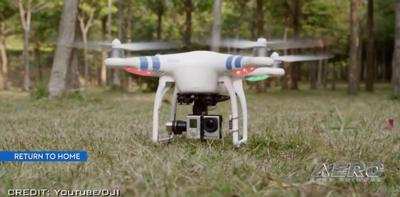Wed, Feb 11, 2015
Was Talking About Safety Of The Aircraft At The Time
It's probably important when you're talking about how safe your UAV is to operate that you don't crash it during the presentation ... particularly if that presentation is being shown live on national television.

But that's exactly what happened to Popular Science Online Editor Dave Mosher appearing on a segment of Fox & Friends on February 4. He was invited on the show to discuss use of the aircraft for purposes like photography, as well as the FAA's regulatory efforts.
According to the Photography Bay website, the UAV was a DJI Phantom 2 Vision + ... the type that wound up on the White House lawn at 3:00 a.m. a couple of weeks ago. The demonstration was taking place at the 2015 Consumer Electronics Show in Las Vegas... where you would expect a lot of Wi-Fi and other RF interference to be floating around the convention center where the event was being held.
During the demonstration, the UAV suddenly darted away from the set and into the area where the cameras were shooting the program, and the crew scattered away from the oncoming aircraft. No amount of explaining could undo the bad publicity done live on national television.
The academy of Model Aeronautics contacted both Fox News and Popular Science, saying in a letter that the demonstration "set a poor example for those new to model aviation, and it goes against the message of safety that our community stands for. Basic research into safety precautions and common sense guidelines would have shown that this was not a responsible use of this technology."
In an response sent to Photography Bay, DJI said that it does not recommend that "inexperienced" pilots fly their UAVs indoors, and that the checklist included with their aircraft specifically discourages "new new pilots from flying close to people and in areas with dense radio frequencies.
"Without knowing the specifics of this demo, I can say that we do not recommend inexperienced pilots to fly indoors without GPS stabilization. Additionally flying nose forward (which changes orientation) and in an environment with significant radio frequency interference without netting is a challenge that we would discourage first time pilots from attempting."
(Image from file)
More News
He Attempted To Restart The Engine Three Times. On The Third Restart Attempt, He Noticed That Flames Were Coming Out From The Right Wing Near The Fuel Cap Analysis: The pilot repor>[...]
Make Sure You NEVER Miss A New Story From Aero-News Network Do you ever feel like you never see posts from a certain person or page on Facebook or Instagram? Here’s how you c>[...]
From 2009 (YouTube Edition): Leading Air Show Performers Give Their Best Advice for Newcomers On December 6th through December 9th, the Paris Las Vegas Hotel hosted over 1,500 air >[...]
Aero Linx: NASA ASRS ASRS captures confidential reports, analyzes the resulting aviation safety data, and disseminates vital information to the aviation community. The ASRS is an i>[...]
“For our inaugural Pylon Racing Seminar in Roswell, we were thrilled to certify 60 pilots across our six closed-course pylon race classes. Not only did this year’s PRS >[...]
 NTSB Final Report: Rutan Long-EZ
NTSB Final Report: Rutan Long-EZ ANN FAQ: Turn On Post Notifications
ANN FAQ: Turn On Post Notifications Classic Aero-TV: ICAS Perspectives - Advice for New Air Show Performers
Classic Aero-TV: ICAS Perspectives - Advice for New Air Show Performers ANN's Daily Aero-Linx (06.28.25)
ANN's Daily Aero-Linx (06.28.25) Aero-News: Quote of the Day (06.28.25)
Aero-News: Quote of the Day (06.28.25)



